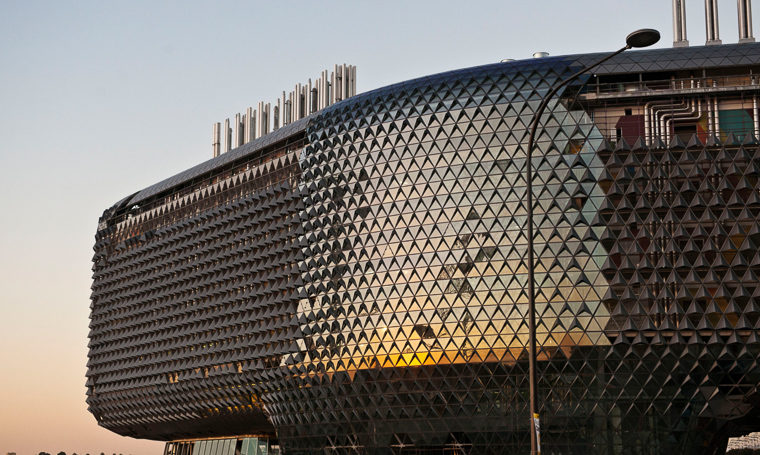The Leadership in Energy & Environmental Design certification recognises best-in-class building strategies and practices. The green certification is recognised across the world.
The certifying body said that SAHMRI earned the honour by taking a systematic and whole-of-life approach to building related environmental impacts and human benefits.
WOODS Bagot, the architectural firm behind SAHMRI, detail the thought that went in to designing such a unique building with such an important task.
Design Statement
Designed by Woods Bagot, the SAHMRI accommodates up to 675 researchers from South Australia and beyond in approximately 25,000 square metres of space within a sculptural building in the heart of Adelaide’s new medical and health precinct, west of the city.
The SAHMRI’s central proposition was to create a liberating new lab typology that promotes collaboration and medical discovery, attracting the best researchers from around the world. The built form of the SAHMRI acknowledges its sense of place within the green belt of the Adelaide parklands, seamlessly interacting with its surroundings, including Adelaide’s public transport, cycling and walking networks. The architecture is lifted, creating an open ground plane in an integrated landscape, opening the building to the public as well as users, allowing for greater activation and porosity through the site. Its forecourt, adjacent to the new hospital, encourages interaction and exchange by staff, visitors and the general public.
Derived from its unique site geometry and the need to create a forecourt entry adjacent to the new hospital to the west, the SAHMRI’s sculptural, iconic form is characterized by a striking transparent facade that unifies the organic diamond-shaped plan while showcasing the two atria inside the building.
One of the design documents from Woods Bagot.
Inspired by the skin of a pine cone, the building’s unique triangulated dia-grid facade responds to its environment like a living organism, acting as an articulated sunshade that deals with sunlight, heat load, glare, and wind deflection, while maintaining views and daylight. Following an intensive environmental analysis with consultants Atelier 10, Woods Bagot used parametric modelling tools to integrate environmental, programmatic, and formal requirements into the facade.
SAHMRI during construction. The building's exterior was inspired by skin of a pine cone.
As part of an innovative sustainability program, the project is the first laboratory building in Australia designed to achieve a LEED Gold rating. Woods Bagot worked collaboratively with Atelier 10 to conduct extensive tests, adjusting the building form to achieve its best solar orientation through passive design of floor plates that respond to the internal program and provides maximum daylight where needed.
The SAHMRI facility is designed to accommodate up to 675 researchers, providing nine fully flexible wet and dry laboratory modules as well as a vivariums, cyclotron, and associated public areas. Woods Bagot worked closely with laboratory design specialists Research Facilities Design (RFD) to determine the current and potential needs of scientists working at the facility. A typical building floor plate consists of two research lab modules which can accommodate a dry lab or wet lab fit-outs. The key driver of the building design is to foster collaboration between researchers, achieved by the introduction of atria and bridges. The visual connection between floors and interconnecting spiral stair will encourage and enhance collaboration between researchers.
SAHMRI's spiral stair helps link floors and encourages collaboration. Photo courtesy of Don Brice.
The write-up spaces on the adjacent north and north-east side is based on a modular design of workplaces from open plan to enclosed meeting rooms and quiet spaces. A large 10.2-metre column layout allows for efficiency and flexibility. The facade allows maximum daylight into these areas as well as borrowed light to the laboratory spaces and enhances external views, creating a healthier internal environment. Transparency also allows the outside views to the internal workings of the building promoting the importance of the activities within.

The vast interior of SAHMRI. Photo courtesy of Don Brice.
For another great article on SAHMRI, check out ArchitectureAU’s in depth look at the sustainable profile of the building at “The SAHMRI: Performance Driven“.
SAHMRI: Captured on film from Woods Bagot on Vimeo.
Fact File: SAHMRI
THE South Australian Health and Biomedical Precinct will be one of the largest health precincts in the southern hemisphere, and SAHMRI is set to be its crown jewel.
SAHMRI will house six expert researchers leading teams and research under several important themes. Some of the prominent professors and doctors include:
- Professor Stephen Nicholls in charge of Heart Health, with the aim of advancing the ability to prevent, detect and treat a range of cardiovascular disease states.
- Professor Alex Brown in charge of Aboriginal Health, with the goal of overcoming chronic disease and other issues that will improve the health and wellbeing of Aboriginal people and communities.
- Professor Julio Licinio in charge of Mind and Brain, examining the connections between metabolic and inflammatory processes and mental health; research at the intersection of neuroscience and mental health.
- Professor Tim Hughes in charge of Cancer, with a focus on translational research in haematology malignancies.
- Professor Maria Makrides in charge of Healthy Mothers, Babies and Children, with the aim of building a state-wide centre that is internationally recognised for improving the health and lives of young families.
- Professor Steve Wesselingh in charge of Infection and Immunity, with a focus on microbiome and metagenomics research.
- Professor Chris Proud is in charge of the Nutrition and Metabolism Theme.
Theme leaders from SAHMRI talk about moving in to the building and setting up their work.

On top of the world recognised research leaders, the health precinct also has direct access to a dedicated skilled workforce, as well as co-located undergraduate and postgraduate students, a capacity which will grow in time as university facilities are constructed on-site.
The precinct will grow in the future, as the New Royal Adelaide Hospital is built adjacent to SAHMRI and, possibly, a proposed ‘SAHMRI 2’ is built as well. Along with dedicated University campuses alongside, the South Australian Health and Biomedical Precinct is set to be a world leading area of research, treatment and education.

Inside looking out. Photo courtesy of Don Brice.






